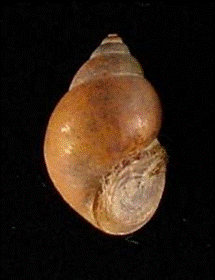|
"Your gateway to
understanding |
European Faucet Snail
click for full size
• Discovered in Oneida Lake around 1915
• Feeds by filtering algae from the water and by grazing on algae attached to submersed surfaces
• Consumed by fish and waterfowl
The transport of the faucet snail from its native range in Europe to North America likely occurred via several vectors including in the solid ballast of transoceanic ships, in marsh grass packing material used to prevent the breakage of delicate cargo, or through intentional introduction. It was first identified in Oneida Lake in 1915 although it was documented in nearby Lake Ontario and the Hudson River in the late 1800s. Abundant in Oneida Lake by the 1960s, this mollusk has been called the “zebra mussel of the Twentieth Century”.
The faucet snail can live up to four years. Shells range in color from light brown to black and can reach just over ½ inch in length. These snails feed by grazing on algae present on submersed surfaces but prefer suspension feeding—a method where algae are filtered from the water. This snail thrived in Oneida Lake’s nutrient and algae rich waters of the 1950s and 1960s. It had a significant impact on the lake’s molluscan fauna causing the extirpation of several important native snail species.
The faucet snail serves as an intermediate host for trematodes (intestinal parasites) that have been implicated in the deaths of waterfowl in the Mississippi basin since 2002. The faucet snail is a newcomer to that area, having arrived in the late 1990s. If the snail population is heavily infected with trematodes, birds may ingest a lethal dose within 24 hours of feeding.
To learn more about European faucet snail ...
European Faucet Snail Factsheet (pdf - 71kb)

